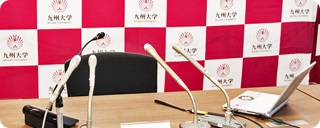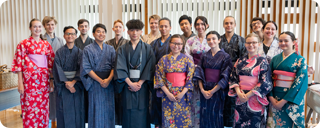研究・産学官民連携 Research
Designing for the Townscape by Design Method of the Systemization and Characterization -Practical Studies of Pubic Design-
- TOP
- Research
- Research at Kyushu University
- Art and Design
- Recent Studies at the Faculty of Design
- Recent studies at the Faculty of Design in 2017
- Designing for the Townscape by Design Method of the Systemization and Characterization -Practical Studies of Pubic Design-
Research Projects and Initiatives
Recent Studies at Faculty of Design
Designing for the Townscape by Design Method of the Systemization and Characterization -Practical Studies of Pubic Design-
Department of Design Strategy,Fuculty of Design
Center for Designed Futures(Director)
Professor Yoshitsugu Morita
Practical public design research is a “practical method for designing attractive and optimal relationships between people, things, and place,” for the purpose of creating emotional value. Public spaces such as urban streets, parks, and facilities that support our lives, become pleasant places when furnished with various elements attractive to the users. In order to create a pleasant place, it is necessary to consider the methods for ordering and individualizing the various elements of the public space. In the case of ordering, for example, we must start by organizing the disorderly elements on the street. In the case of individualization, for example, it is required that we characterize the street according to its environmental features, select the elements necessitated by that characterization, and derive a harmonious and coherent charm from the elements’ interplay. Even if each and every element’s design is excellent, if the elements are not in harmony with each other, the result will be a mismatched urban design. Moreover, and importantly, order is an indispensable prerequisite for individualization, since a unique and attractive place can only be created in an organized environment. In other words, public design can be said to be a design of the relationship between the functionally negative design of “ordering” and the emotionally appealing design of “individualization.”

Writer recent photograph
■Method of Public Design
For “systemization” and “characterization” designs, it is important for one to understand the distinguishing characteristics of the historical/cultural background, and so forth, of the subject to be designed and determine the casting of leading and supporting roles when creating value for this subject. Public design is the process of visualization after determining the direction of the vector that connects the relationship among the following three values: the space value of “things and place,” the information value of “circumstances,” and “time.” In other words, the method of public design involves determining how to build a relationship that creates value for space, information, and time, upon deciding the “characterization” vector that acts as the lead and the “systemization” vector that acts in a supporting role.
■Example of Public Design Put into Practice
For all of these projects, functions were systematized in order to ensure good space utilization, and kansei was characterized to reflect the regional identity and locality of Fukuoka. By doing so, both systematization and characterization were balanced, and the projects received the Good Design Prize and other awards.
1. Harumi Street, Ginza (Chuo-ku, Tokyo)
Harumi Street Design Project, Ginza, Tokyo, Japan : 1989
<Japan Urban Design Award 1993>


2. Sign Ring, West Shinjuku (Shinjuku-ku, Tokyo)
Sign Ling of West Shinjyuku District, Tokyo, Japan : 1991
<25th Japan Sign Design Award, Grand Prize ・ Minister of International Trade and Industry Award 1991>
The project of this me is the probably world's first example that gathered a signal, light, signs in the characterized crossing sign ling.
Recently, the sign ling became the topic in what was taken up in the scene of the movie “your name. (2016-2017)”.


3. Nishi-Nakashima Bridge (Chuo-ku, Fukuoka)
Nishi-Nakashima Bridge, Fukuoka, Japan : 2003
<Good Design Award of Japan, 2003>


4. JR Hakata Station Front Plaza, (Hakata-ku, Fukuoka)
JR Hakata Station Front Plaza, Japan : 2011
<Good Design Award 2011>
The basic concept for this project - the Plaza design - was established at the “Investigative commission for the upgrading of Hakata Station Front Plaza" in March 2010 upon discussions between residents, the government, relevant business operators, and specialists that included the author. With the formulation of “activity and interaction”, “a landscape that symbolizes the allure of Fukuoka and Hakata”, and “a comfortable and highly convenient traffic node space” as the essential features, a design policy to create an overall harmony and attractiveness for the plaza by limiting installment of artificial objects to encourage movement but at the same time encouraging people to loiter. As such, in the following year (fiscal year 2010), upon the request of Fukuoka City, the authors came to be in charge of the implementation design. In order to fashion a harmonized and appealing Station Front Plaza, the method of "a public design based on systematization and characterization”, a design founded on the diverse relations between elements that form the plaza, was employed. The Station Front Plaza was given a simple and easy-to-comprehend ordered design that harmonized facilities and fixtures such as entrance to the underground, bus stop, signs, lightings, with the station building and surrounding landscape. The plaza’s outdoor life stage such as pavement, greenery, and benches were given a characteristic style that expressed Hakata and Fukuoka. Systematization is a subtractive design. For example, the 12-meter high road lighting shares its position with the traffic signal and signs, and is made up of 4 square pipes to lessen the presence of the pillar itself. The square pipes were painted in dark and light grey tones to harmonize or be in order with the station building façade. The pavement is what will give the overall impression to the entire plaza by being characteristic. The connection between Hakata and Fukuoka known as the twin cities was expressed as a rhythm woven by the north and south / east and west band pattern. This band rhythm with gradation is focused towards the center of the plaza as if to guide people to the Tenjin district in Fukuoka from the Hakata Station which is Hakata’s hub. The characterization design is formed by connecting the value extracted from the characteristics of an area, the people, and the elements into an attractive design where everything is tied in, and becomes a formed design only when the environment is ordered and organized.
Façade: From French (façade), referring to the front part of a building. Corresponds to the “face” of a human being. Also for buildings, it is a part that plays an important role in terms of design. It is also an important component in urban landscape creation, where it is essential to create harmonious fa?ades while giving due consideration to the surrounding environment, etc.




■Inquiries
Department of Design Strategy,Fuculty of Design
Professor Yoshitsugu Morita
- TOP
- Research
- Research at Kyushu University
- Art and Design
- Recent Studies at the Faculty of Design
- Recent studies at the Faculty of Design in 2017
- Designing for the Townscape by Design Method of the Systemization and Characterization -Practical Studies of Pubic Design-































